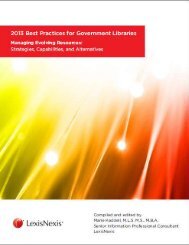2012 Best Practices for Government Libraries
2012 Best Practices for Government Libraries
2012 Best Practices for Government Libraries
Create successful ePaper yourself
Turn your PDF publications into a flip-book with our unique Google optimized e-Paper software.
99<br />
BEST PRACTICES <strong>2012</strong><br />
established, however, the importance of tracking, revisiting and using your blog’s<br />
analytics should remain a priority.<br />
Your analytics plat<strong>for</strong>m can provide you with a variety of important insights, including:<br />
How many people visit your blog<br />
Which posts are the most popular<br />
What day of the week or time of day is the busiest <strong>for</strong> your blog<br />
How people are finding your blog (i.e., through the university or company website,<br />
Google, etc.)<br />
What search terms people are looking <strong>for</strong> on the blog<br />
How much time people are spending on your blog<br />
The above list is just a sample of analytics you can track and use. The analytics you<br />
choose to review should help you gain insight into your readers’ behaviors, which will help<br />
you and/or your team blog about the topics that seem to be most important to your<br />
readers.<br />
Remember that analytics also are great to report to library leadership, who should view<br />
the blog analytics (assuming the news is good, of course) as a measurement of positive<br />
ROI on your ef<strong>for</strong>ts. My advice: get into the habit of sending a monthly report to library<br />
stakeholders, which tracks month-over-month, or even year-over-year, analytics<br />
comparisons. A simple explanation of the numbers is just as important to include as the<br />
numbers themselves, too.<br />
Get Social<br />
Readers not only love to read blog posts, but comment on them as well. Make sure your<br />
blog has a commenting functionality turned on. As you will see below, our Library Connect<br />
blog has a commenting “plug in” that allows our readers to post their ideas and opinions<br />
to any of our blog posts and articles. Your blog might already have this functionality<br />
available. If not, make sure you add it as soon as possible. It’s a great way to gather<br />
instant feedback, engage with your readers, and <strong>for</strong> your readers to interact with you and<br />
each other.<br />
Another important “social” component to add to your blog is the sharing functionality,<br />
which will make it possible <strong>for</strong> readers to share your blog posts via Twitter, Facebook,<br />
Google+, and their other social media networks. Blatant plug alert: be sure to share<br />
this post with your social networks!<br />
Be Mobile<br />
According to recent stats I just reviewed (see full report), there are close to 1.2 billion<br />
mobile Web users in the world, and mobile devices account <strong>for</strong> roughly 8.5% of global<br />
Website hits. In addition, some mobile users do not, or very rarely, use a desktop, laptop<br />
or tablet to access the Web. In the U.S., <strong>for</strong> example, 25% of mobile Web users are<br />
mobile-only.



